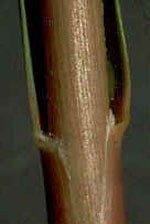Threats to Birds - Smooth Cordgrass (Spartina alterniflora)
Overview
Smooth cordgrass is a native perennial salt marsh grass planted widely for shoreline protection and tidal marsh restoration. Commonly found in open coastal marshes from Newfoundland south to Florida and Texas, it is the most extensive and productive salt marsh grass along the East and Gulf Coasts. However, in the Northwest, it is invasive and excludes native plant species and reduces suitable feeding habitat for waterfowl and wading birds. Smooth Cordgrass was first introduced into Willapa Bay in 1894 in a shipment of eastern oyster spat. It has destroyed 18,000 acres of mudflat habitat for shorebirds in Willapa Bay National Wildlife Refuge. This is the largest infestation of any estuary on the Pacific coast, which is home to 250 species of birds and hosts some of the largest populations of shorebirds on the west coast. Smooth Cordgrass is also found in San Francisco Bay and Humbolt Bay in California, in Puget Sound, WA, and in the Siuslaw estuary in Oregon.
Description A deep-rooting perennial growing 2 - 4 feet tall, spreading by stout fleshy rhizomes, forming large clumps and extensive meadows. Leaves are green or greyish-green and stems are hollow and hairless.
Birds Affected
Short-billed Dowitcher; Dunlin; Pacific Golden-Plover; American Golden-Plover; Whimbrel; Marbled Godwit; Red Knot.
Control
Application of herbicides is most frequently used to control Cordgrass because it is practical and cost-effective. The herbicides Fluazifop (Fusilade) and Haloxyfop (Gallant) both regularly achieve over 90% after one application. Complete eradication requires repeated applications. Smothering with plastic sheeting, burying and repetitive burning have also achieved kill rates of over 90%. However, these methods are more costly and not always practical. Mowing can contain growth, limit seed set and if done repeatedly can kill the plant. |
